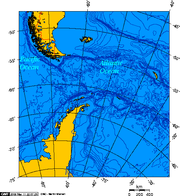- Drake-Passage
-
Als Drakestraße wird die Wasserstraße zwischen der Südspitze Südamerikas (Kap Hoorn) und der Nordspitze der antarktischen Halbinsel bezeichnet. Sie verbindet den Atlantischen Ozean mit dem Pazifischen Ozean und gehört zum Südlichen Ozean. Sie ist nach Francis Drake benannt, da dieser sie auf seiner Weltumsegelung, auf der Suche nach zwei im Sturm abgetriebenen Begleitschiffen, zufällig entdeckte. Das Seegebiet wurde erstmals 1616 von Willem Cornelisz Schouten befahren, der die Straße ursprünglich nach Jakob Le Maire, dem Entdecker Kap Hoorns, Strait of Le Maire benannte. Es ist möglich, dass das Gebiet bereits vor Drake und Schouten von den spanischen Kapitänen Francisco de Hoces (1526) und Gabriel de Castilla (1603) befahren wurde. Deshalb wird die Meeresstraße in spanischen, argentinischen und chilenischen Quellen oft auch als "Mar de Hoces" bezeichnet.
Im spanischen wird allerdings unter „Estrecho de Le Maire“ der Durchgang zwischen Feuerland und Staateninsel verstanden.
Die Straße ist 700 Seemeilen breit und fast frei von Inseln, was dem Antarktischen Zirkumpolarstrom die Möglichkeit gibt, als einzige Meeresströmung den gesamten Globus zu umfließen. Dies verhindert das Vordringen wärmeren Wassers an die Antarktische Küste und ermöglicht so erst die Ausbildung der gewaltigen Eiskappe. Bis vor etwa 41 Millionen Jahren war die Drakestraße noch verschlossen und die Antarktis wesentlich wärmer als heute, vergleichbar dem heutigen Skandinavien.
Die Tierwelt des Seegebietes ist reichhaltig. Wale und Delfine aber auch Albatrosse oder Pinguine können beobachtet werden. -58.580213888889-62.9095Koordinaten: 58° 34′ 49″ S, 62° 54′ 34″ W
Wikimedia Foundation.


